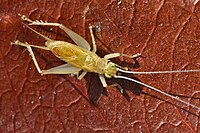
Savi's warbler is a species of Old World warbler in the grass warbler genus Locustella. It breeds in Europe and the western Palearctic. It is migratory, wintering in northern and sub-Saharan Africa.

The family Gryllidae contains the subfamilies and genera which entomologists now term true crickets. Having long, whip-like antennae, they belong to the Orthopteran suborder Ensifera, which has been greatly reduced in the last 100 years : taxa such as the spider-crickets and allies, sword-tail crickets, wood or ground crickets and scaly crickets have been elevated to family level. The type genus is Gryllus and the first use of the family name "Gryllidae" was by Walker.

Gryllus pennsylvanicus is known as the fall field cricket. G. pennsylvanicus is common in southern Ontario, is widespread across much of North America and can be found even into parts of northern Mexico. It tends to be absent in most of the southwestern United States including southern California. Within its geographic range this field cricket will burrow into soil in fields and forest edges. Individuals inhabit grassy disturbed areas and are often found around areas of human habitation.

Meconema meridionale is an insect in the family Tettigoniidae, known as the southern oak bush cricket.

Calliptamus siciliae, commonly known as the pygmy pincer grasshopper, is a species of short-horned grasshoppers belonging to the family Acrididae subfamily Calliptaminae.

Gryllomorpha dalmatina, common name wingless house-cricket, is a species of cricket belonging to the family Gryllidae subfamily Gryllomorphinae.

Metaplastes pulchripennis, common name Italian ornate bush-cricket, is a species of 'katydids crickets' belonging to the family Tettigoniidae subfamily Phaneropterinae.

Yersinella raymondi, common name Raymond's Bush-cricket, is a species of "katydids crickets" belonging to the family Tettigoniidae subfamily Tettigoniinae. The scientific name Yersinella comes from the name of the entomologist who has described the species in 1860.

Conocephalus fuscus, the long-winged conehead, is a member of the family Tettigoniidae, the bush-crickets and is distributed through much of Europe and temperate Asia. This bush-cricket is native to the British Isles where it may confused with the short-winged conehead. These two species are phenotypically similar; however, the distinguishing factor between the two is the fully developed set of wings the long-winged conehead possesses that allows for flight. In the short-winged coneheads the hind wings are shorter than the abdomen, causing the wings to be vestigial and the species is incapable of flight. For this reason it is hard to discriminate between the two species during the early stages of their life cycle before the wings have fully developed. The colouration of the conehead is typically a grass green with a distinctive brown stripe down its back, though there are some brown phenotypes.

Barbitistes obtusus, common name Southern Saw-tailed Bush-cricket or Alpine Saw Bush-cricket, is a species of katydids crickets in family Phaneropteridae subfamily Phaneropterinae.

Brachytrupes megacephalus is a species of cricket in the family Gryllidae.

Leptophyes laticauda is a species of bush-crickets belonging to the family Tettigoniidae.
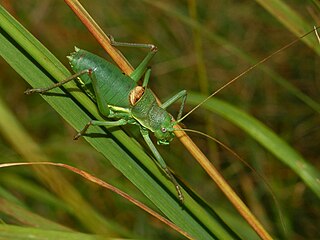
Ephippiger perforatus, the North Apennine saddle bush-cricket, is a species of insect in the family Tettigoniidae.
Tessellana lagrecai, known as La Greca's slender bush-cricket, is a species of bush-cricket in the family Tettigoniidae. Described by Messina in 1979, the species is found in grasslands and shrublands in Sicily, Italy. It is considered a vulnerable species by the IUCN.

Eyprepocnemis plorans, the lamenting grasshopper, is a species of insect in the family Acrididae. It is the type species of the genus Eyprepocnemis, and is found in Africa, parts of the Middle East, and southern Europe. It typically inhabits wetlands and other moist habitats.
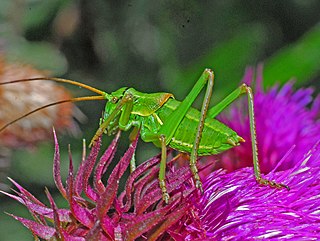
Ephippiger terrestris, common name Alpine saddle-backed bush-cricket, is a bush cricket species belonging to the family Tettigoniidae, subfamily Bradyporinae.
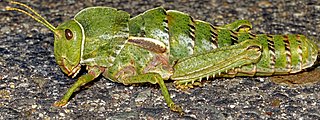
Pamphagus sardeus is a large species of Pamphagidae and one of the most massive Italian Orthoptera.

Svercus palmetorum is a small species of cricket, and the sole member of the genus Svercus.
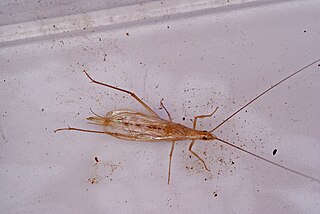
Oecanthus dulcisonans is a species of cricket sparsely but widely distributed in the Mediterranean Basin and in the Middle East.

Barbitistes vicetinus, the Vicentine saw-tailed bush-cricket, is a species of katydids crickets in family Phaneropteridae endemic to Italy. The species was originally described by Antonio Galvagni and Paolo Fontana. It is found in vineyards and woody vegetation in the regions of Veneto and Trentino, in particular in the province of Vicenza. In 2016, it was listed as a Near Threatened species by the IUCN due to its restricted geographic range and extreme fluctuations in its population: its current extent of occurrence (EOO) is about 580 km2 (220 sq mi), and its area of occupancy (AOO) is between 50–100 km2 (19–39 sq mi). Formally described as a new species only in 1993, unexpected population outbreaks have severely impacted forests and crops in northern Italy in recent years.



